Biostatistics: Sample Size Determination using Cochran’s Formula
VerifiedAdded on 2023/04/20
|10
|629
|80
Report
AI Summary
This report provides definitions for key biostatistical terms such as point estimate, standard error, confidence level, and margin of error. It discusses methods of sample size determination, focusing on Cochran’s formula and its application in situations with large populations. The report highlights the advantages and limitations of both small and large sample sizes, noting the trade-offs between cost, accuracy, and the ability to capture diversity. References to relevant research articles are included, offering further reading on the topics discussed. Desklib provides this and other solved assignments to aid students in their studies.

Biostatistics
By (Name of Student)
By (Name of Student)
Paraphrase This Document
Need a fresh take? Get an instant paraphrase of this document with our AI Paraphraser
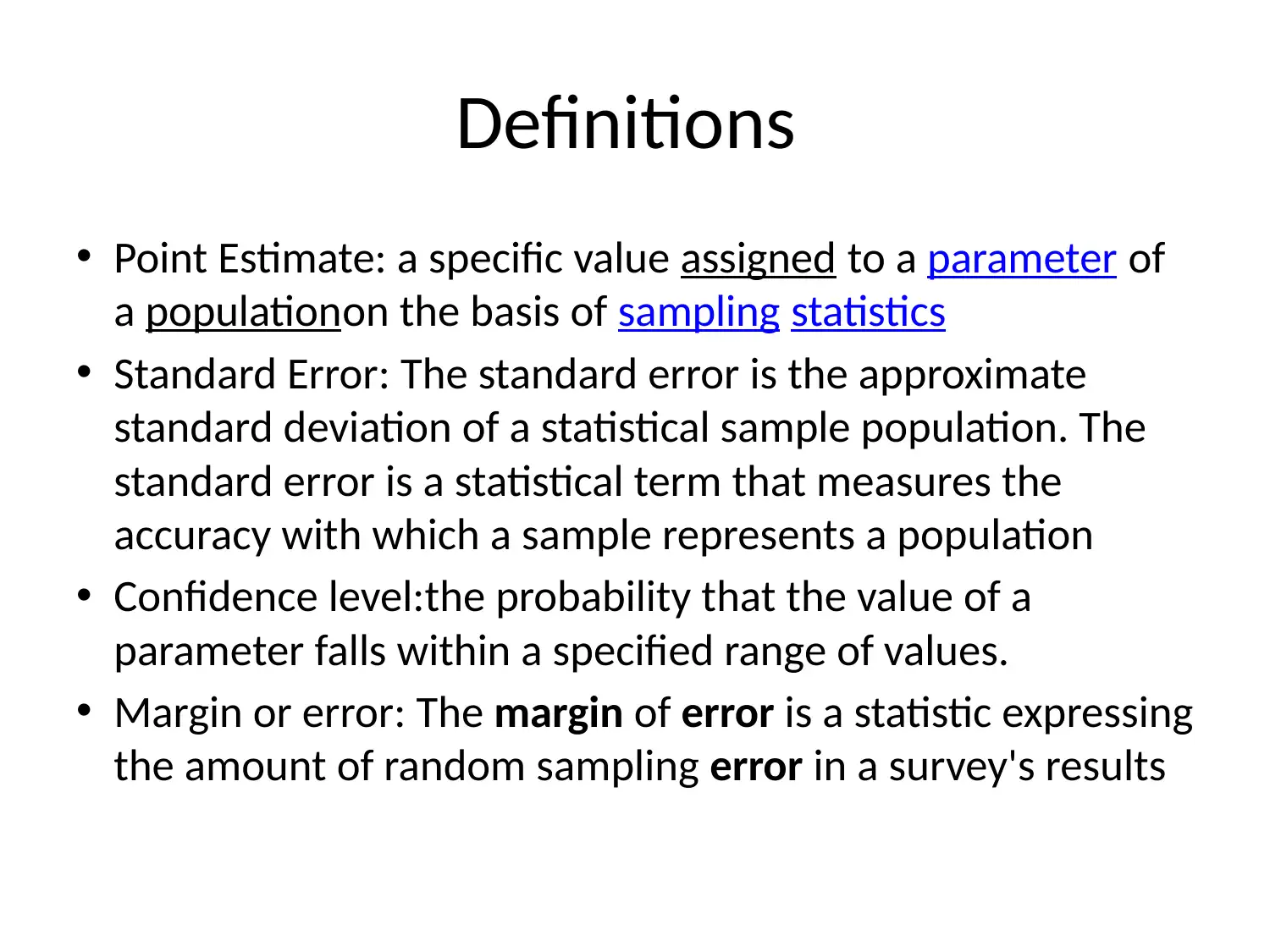
Definitions
• Point Estimate: a specific value assigned to a parameter of
a populationon the basis of sampling statistics
• Standard Error: The standard error is the approximate
standard deviation of a statistical sample population. The
standard error is a statistical term that measures the
accuracy with which a sample represents a population
• Confidence level:the probability that the value of a
parameter falls within a specified range of values.
• Margin or error: The margin of error is a statistic expressing
the amount of random sampling error in a survey's results
• Point Estimate: a specific value assigned to a parameter of
a populationon the basis of sampling statistics
• Standard Error: The standard error is the approximate
standard deviation of a statistical sample population. The
standard error is a statistical term that measures the
accuracy with which a sample represents a population
• Confidence level:the probability that the value of a
parameter falls within a specified range of values.
• Margin or error: The margin of error is a statistic expressing
the amount of random sampling error in a survey's results
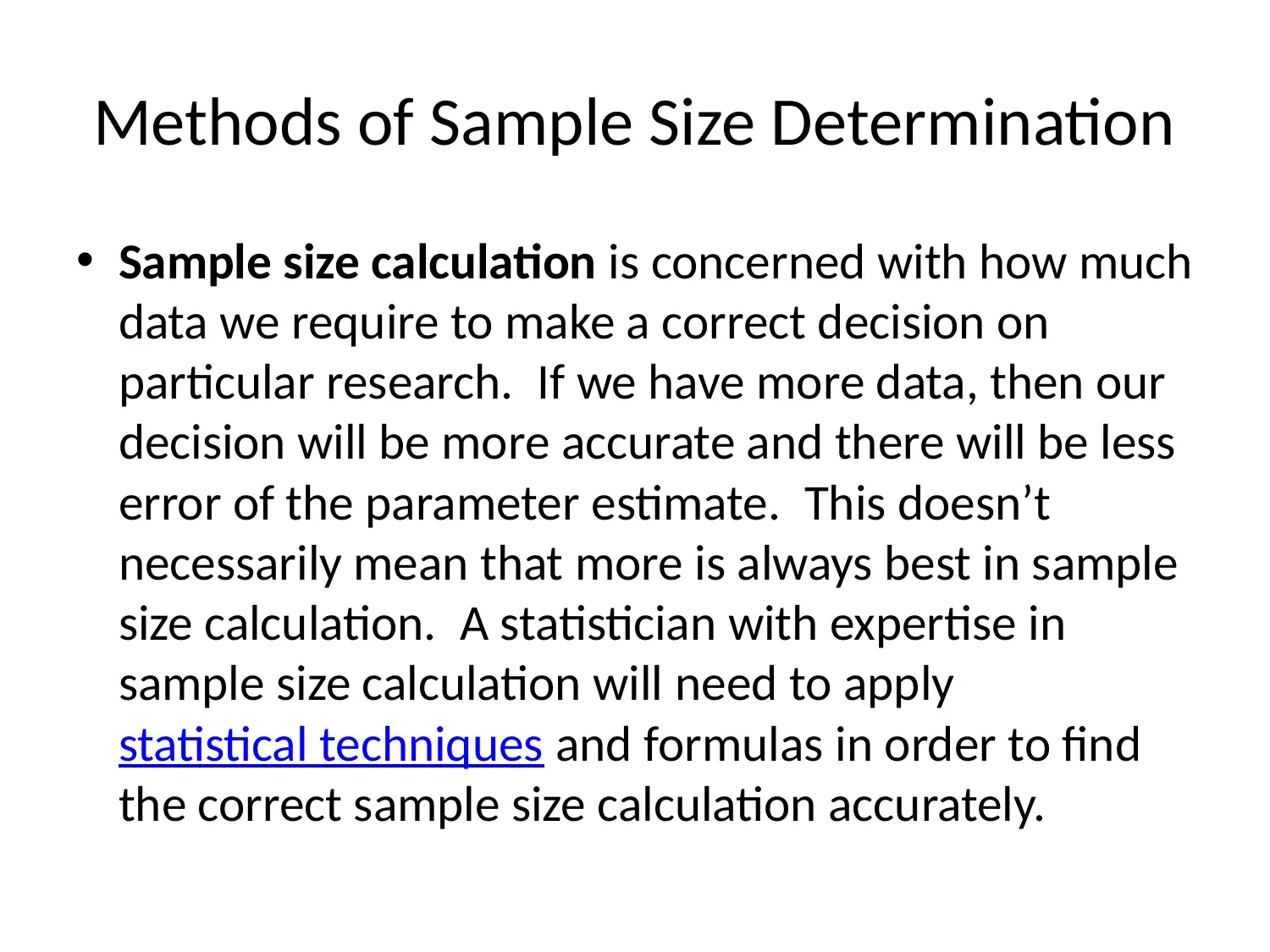
Methods of Sample Size Determination
• Sample size calculation is concerned with how much
data we require to make a correct decision on
particular research. If we have more data, then our
decision will be more accurate and there will be less
error of the parameter estimate. This doesn’t
necessarily mean that more is always best in sample
size calculation. A statistician with expertise in
sample size calculation will need to apply
statistical techniques and formulas in order to find
the correct sample size calculation accurately.
• Sample size calculation is concerned with how much
data we require to make a correct decision on
particular research. If we have more data, then our
decision will be more accurate and there will be less
error of the parameter estimate. This doesn’t
necessarily mean that more is always best in sample
size calculation. A statistician with expertise in
sample size calculation will need to apply
statistical techniques and formulas in order to find
the correct sample size calculation accurately.
⊘ This is a preview!⊘
Do you want full access?
Subscribe today to unlock all pages.

Trusted by 1+ million students worldwide
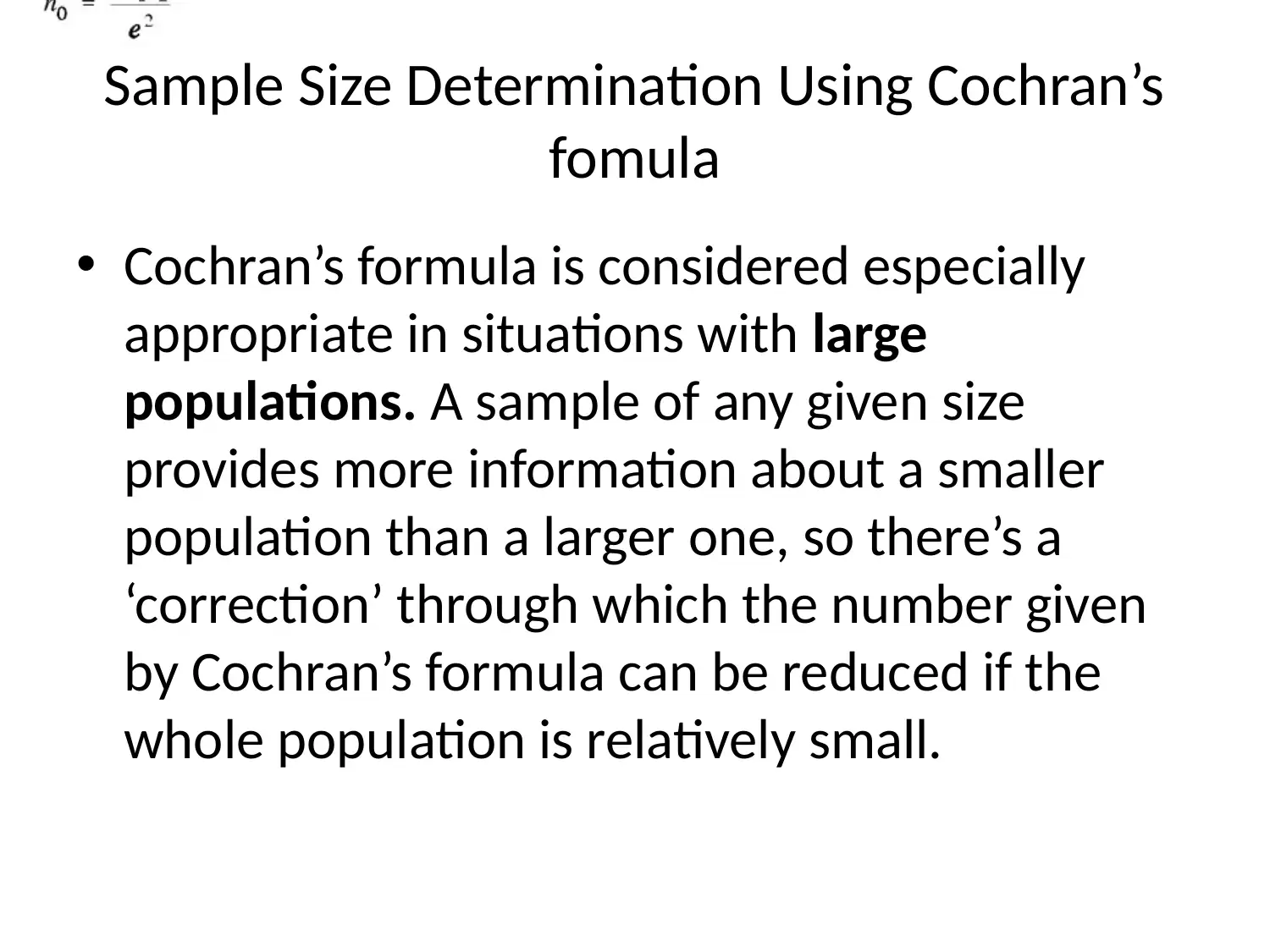
Sample Size Determination Using Cochran’s
fomula
• Cochran’s formula is considered especially
appropriate in situations with large
populations. A sample of any given size
provides more information about a smaller
population than a larger one, so there’s a
‘correction’ through which the number given
by Cochran’s formula can be reduced if the
whole population is relatively small.
fomula
• Cochran’s formula is considered especially
appropriate in situations with large
populations. A sample of any given size
provides more information about a smaller
population than a larger one, so there’s a
‘correction’ through which the number given
by Cochran’s formula can be reduced if the
whole population is relatively small.
Paraphrase This Document
Need a fresh take? Get an instant paraphrase of this document with our AI Paraphraser
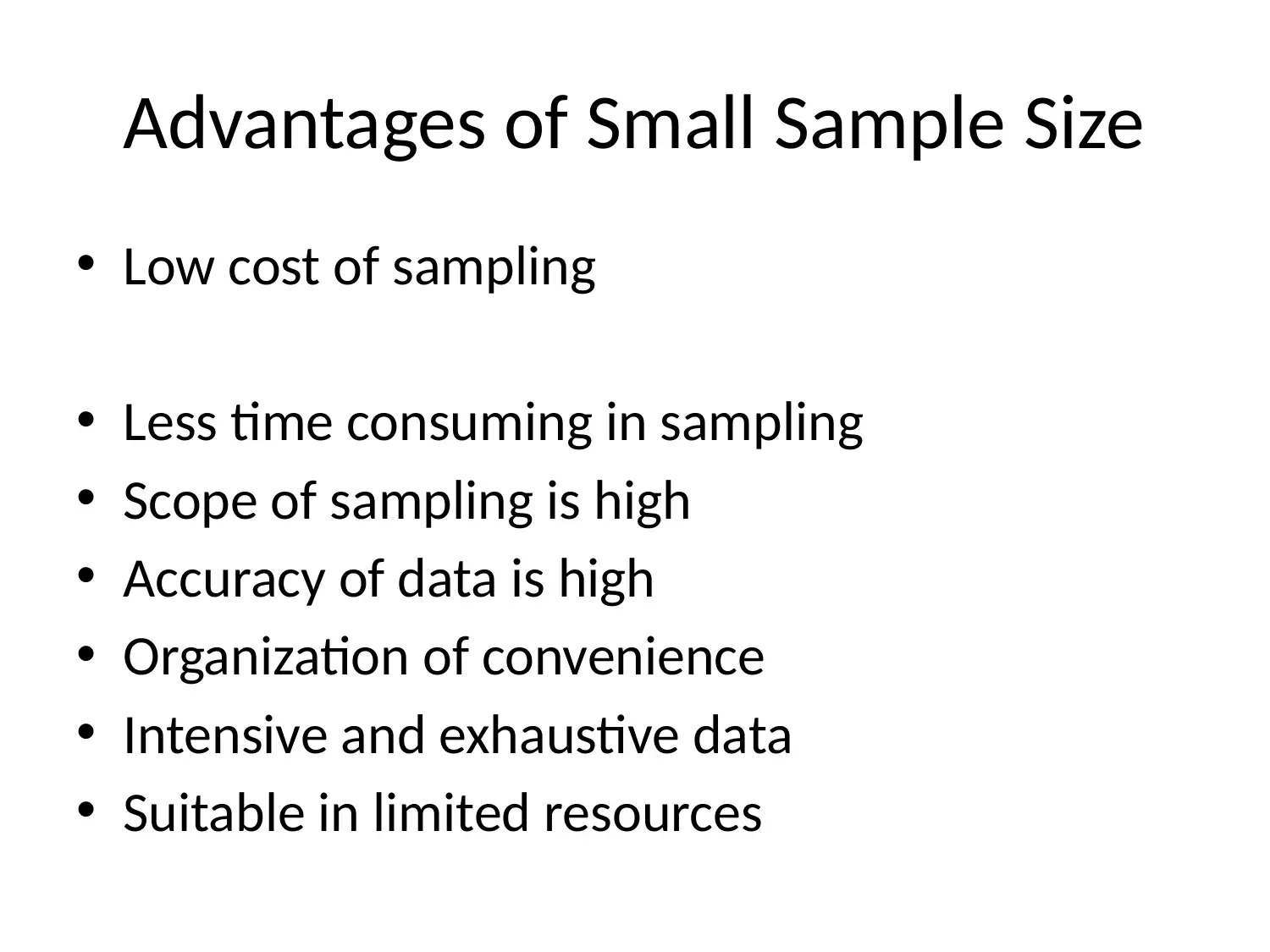
Advantages of Small Sample Size
• Low cost of sampling
• Less time consuming in sampling
• Scope of sampling is high
• Accuracy of data is high
• Organization of convenience
• Intensive and exhaustive data
• Suitable in limited resources
• Low cost of sampling
• Less time consuming in sampling
• Scope of sampling is high
• Accuracy of data is high
• Organization of convenience
• Intensive and exhaustive data
• Suitable in limited resources
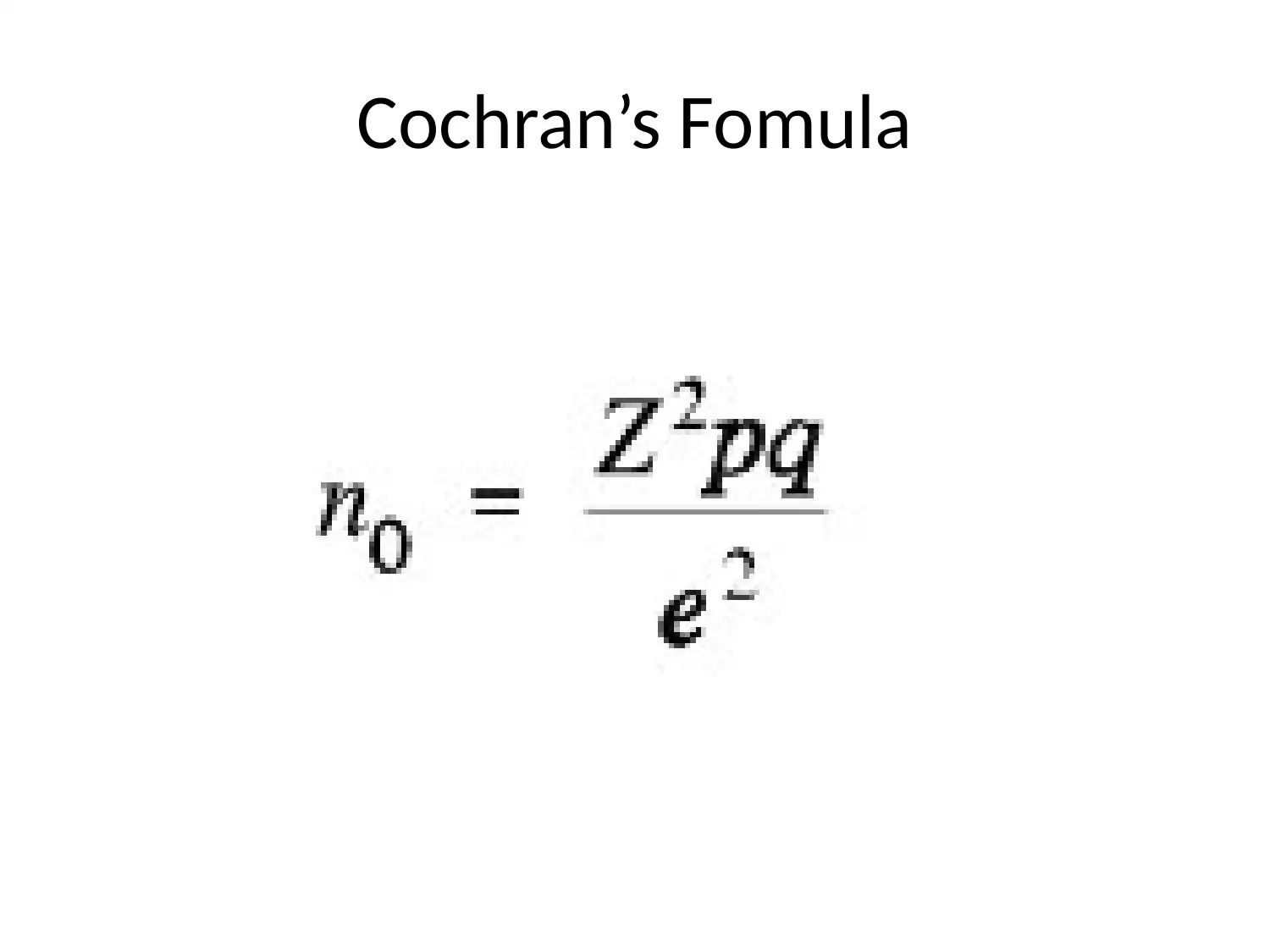
Cochran’s Fomula
⊘ This is a preview!⊘
Do you want full access?
Subscribe today to unlock all pages.

Trusted by 1+ million students worldwide
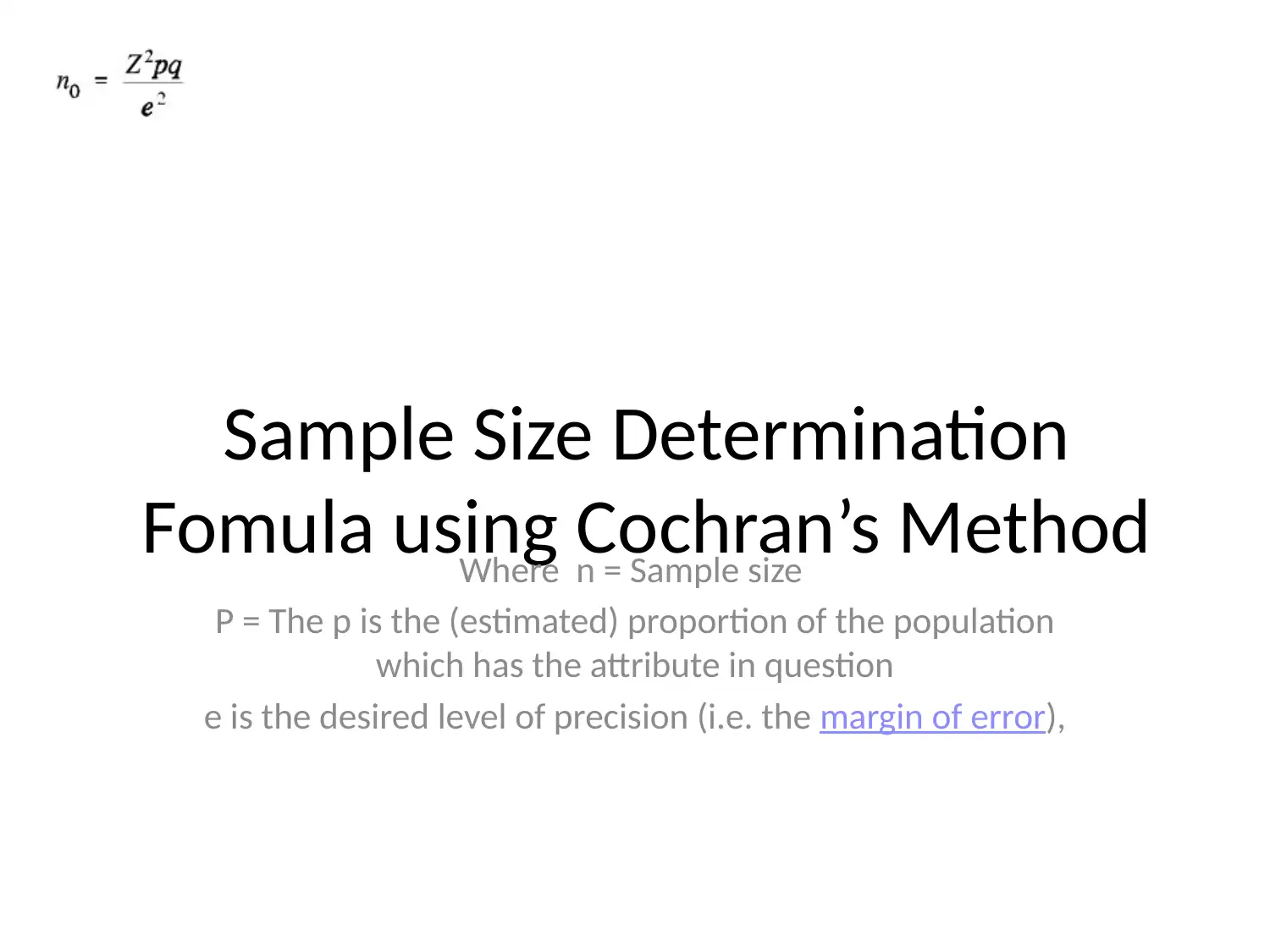
Sample Size Determination
Fomula using Cochran’s MethodWhere n = Sample size
P = The p is the (estimated) proportion of the population
which has the attribute in question
e is the desired level of precision (i.e. the margin of error),
Fomula using Cochran’s MethodWhere n = Sample size
P = The p is the (estimated) proportion of the population
which has the attribute in question
e is the desired level of precision (i.e. the margin of error),
Paraphrase This Document
Need a fresh take? Get an instant paraphrase of this document with our AI Paraphraser
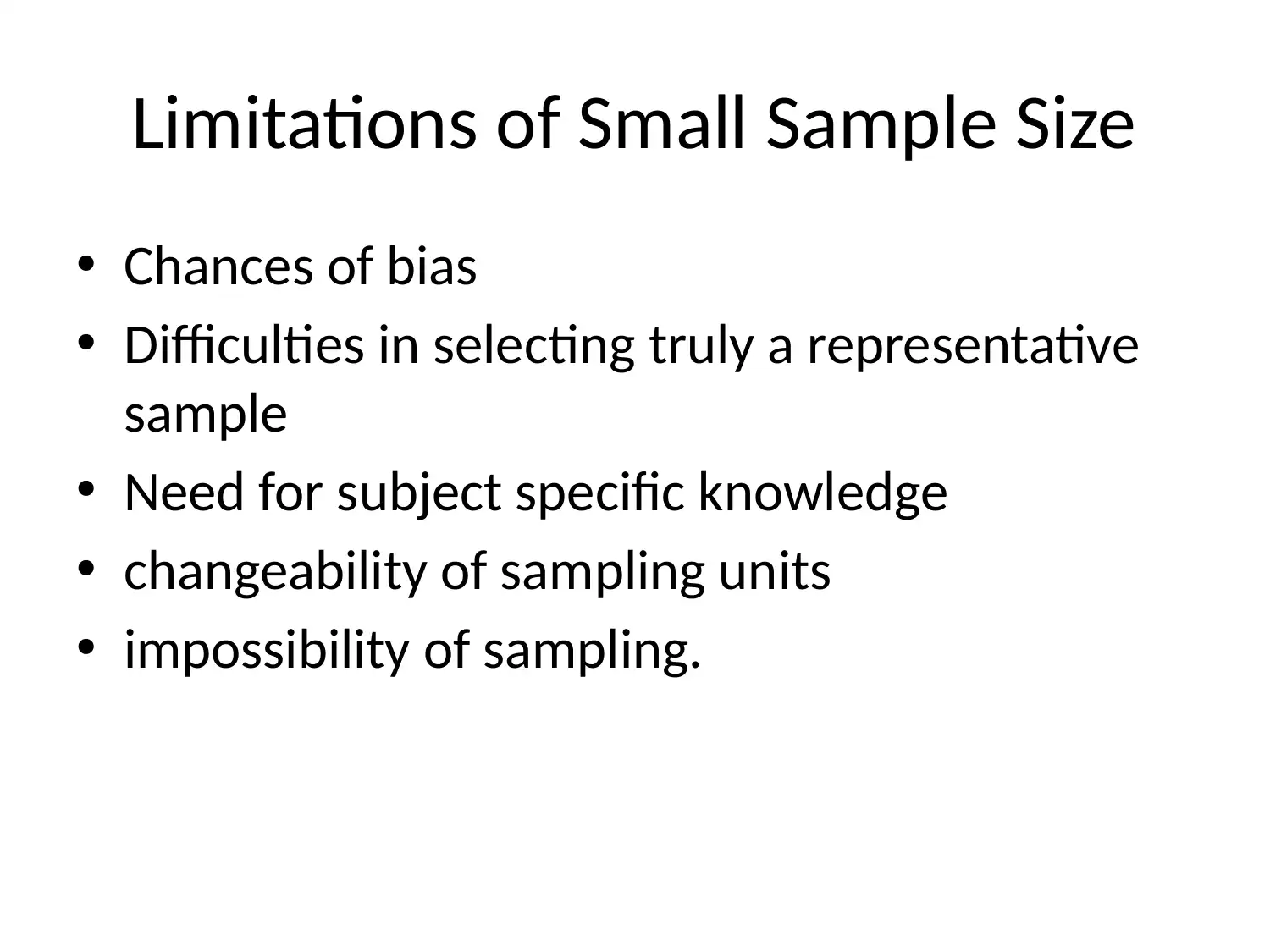
Limitations of Small Sample Size
• Chances of bias
• Difficulties in selecting truly a representative
sample
• Need for subject specific knowledge
• changeability of sampling units
• impossibility of sampling.
• Chances of bias
• Difficulties in selecting truly a representative
sample
• Need for subject specific knowledge
• changeability of sampling units
• impossibility of sampling.
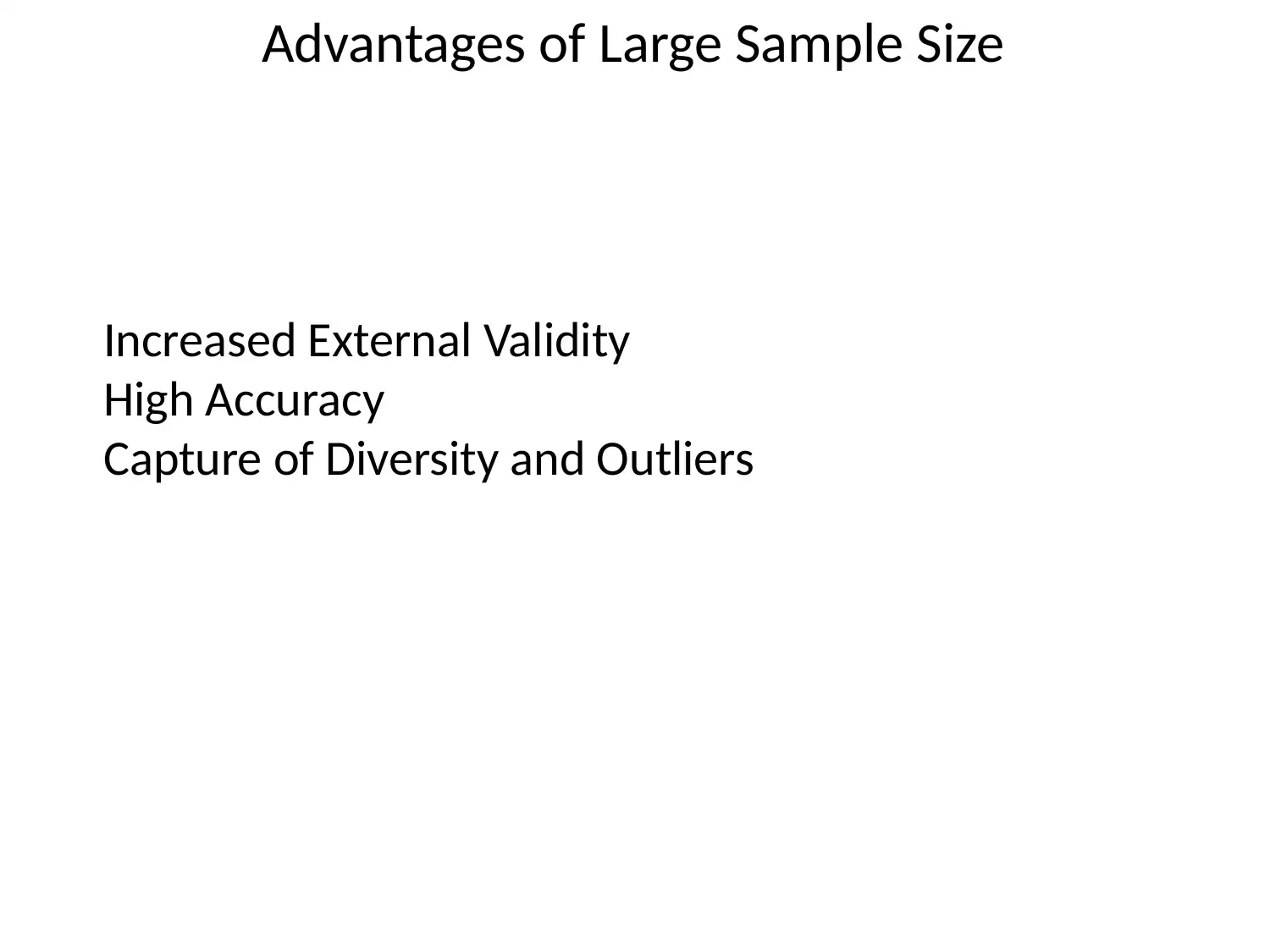
Advantages of Large Sample Size
Increased External Validity
High Accuracy
Capture of Diversity and Outliers
Increased External Validity
High Accuracy
Capture of Diversity and Outliers
⊘ This is a preview!⊘
Do you want full access?
Subscribe today to unlock all pages.

Trusted by 1+ million students worldwide
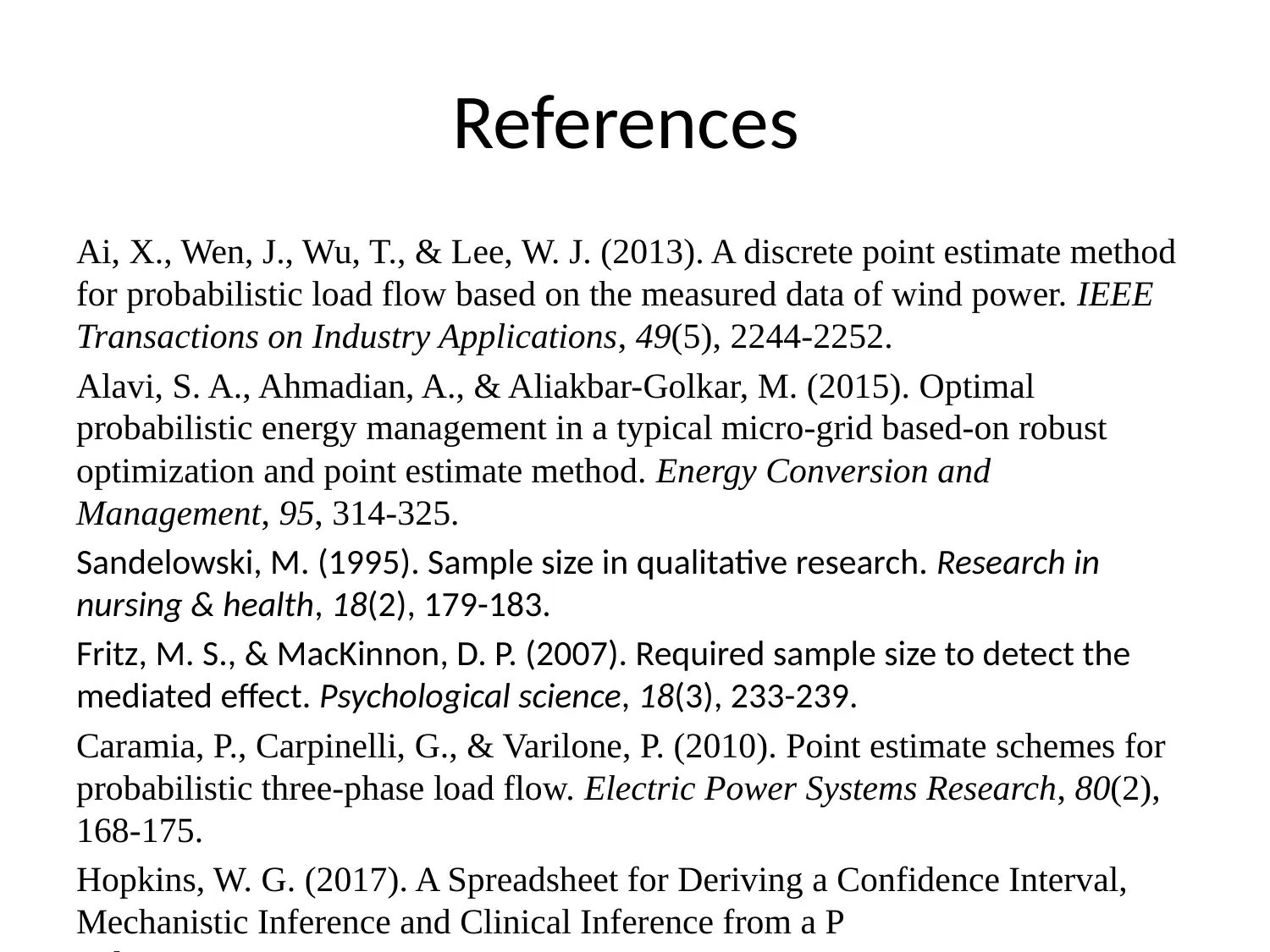
References
Ai, X., Wen, J., Wu, T., & Lee, W. J. (2013). A discrete point estimate method
for probabilistic load flow based on the measured data of wind power. IEEE
Transactions on Industry Applications, 49(5), 2244-2252.
Alavi, S. A., Ahmadian, A., & Aliakbar-Golkar, M. (2015). Optimal
probabilistic energy management in a typical micro-grid based-on robust
optimization and point estimate method. Energy Conversion and
Management, 95, 314-325.
Sandelowski, M. (1995). Sample size in qualitative research. Research in
nursing & health, 18(2), 179-183.
Fritz, M. S., & MacKinnon, D. P. (2007). Required sample size to detect the
mediated effect. Psychological science, 18(3), 233-239.
Caramia, P., Carpinelli, G., & Varilone, P. (2010). Point estimate schemes for
probabilistic three-phase load flow. Electric Power Systems Research, 80(2),
168-175.
Hopkins, W. G. (2017). A Spreadsheet for Deriving a Confidence Interval,
Mechanistic Inference and Clinical Inference from a P
Ai, X., Wen, J., Wu, T., & Lee, W. J. (2013). A discrete point estimate method
for probabilistic load flow based on the measured data of wind power. IEEE
Transactions on Industry Applications, 49(5), 2244-2252.
Alavi, S. A., Ahmadian, A., & Aliakbar-Golkar, M. (2015). Optimal
probabilistic energy management in a typical micro-grid based-on robust
optimization and point estimate method. Energy Conversion and
Management, 95, 314-325.
Sandelowski, M. (1995). Sample size in qualitative research. Research in
nursing & health, 18(2), 179-183.
Fritz, M. S., & MacKinnon, D. P. (2007). Required sample size to detect the
mediated effect. Psychological science, 18(3), 233-239.
Caramia, P., Carpinelli, G., & Varilone, P. (2010). Point estimate schemes for
probabilistic three-phase load flow. Electric Power Systems Research, 80(2),
168-175.
Hopkins, W. G. (2017). A Spreadsheet for Deriving a Confidence Interval,
Mechanistic Inference and Clinical Inference from a P
1 out of 10
Related Documents
Your All-in-One AI-Powered Toolkit for Academic Success.
+13062052269
info@desklib.com
Available 24*7 on WhatsApp / Email
![[object Object]](/_next/static/media/star-bottom.7253800d.svg)
Unlock your academic potential
Copyright © 2020–2025 A2Z Services. All Rights Reserved. Developed and managed by ZUCOL.





